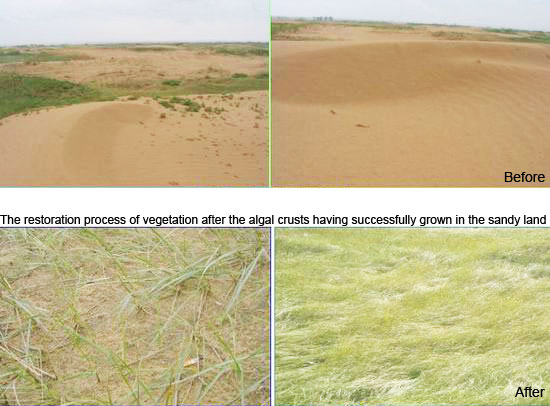
Newsroom
"Engineering Application of Integrative Artificial Algal Crust Technology in Shifting Sand Stabilization" Passes Appraisal
NSFC president Prof. Yiyu CHEN (1st R) together with other experts investigated at the field experiment base of desert algae located in Dalate Qi, southwest part of Inner Mongolia Autonomous Region.
NSFC president Prof. Yiyu CHEN, also academician of the CAS, together with 8 other experts including Prof. Weilun Yi, president of Beijing Forestry University and academician of the CAE (Chinese Academy of Engineering), Prof. Daoji CAI, academician of the CAE, Prof. Wenxuan CAO, academician of the CAS, Mr. Weixi YANG, chief engineer of the Prevention and Control of Desertification Office of the State Forestry Administration had a field survey at the Field Experiment Base of desert algae located in Dalate Qi, southwest part of Inner Mongolia.
Based on two major desert algae i.e., Microcoleus vaginatus Gom and Scytonema javanicum (kütz.) Born et Flah, which are inoculated onto the surface of sand dunes to form artificial algal crust, this project aims at stabilizing the sand surface. The ecological restoration of desertified land is realized by resorting to both artificial algal crust and grass-shrub vegetation. The newly achieved results indicate the adaptive mechanism of typical desert algae living in drought condition, thus revealing the potential of algal crust in sand stabilization, soil forming process and exploration etc. By conforming to China’s current ecological status, this project makes real the possibility of engineering application of artificial algal crusts and bunch production of desert algae seed. It also proves that this technology by applying cyanobacteria, grasses and shrubs to the desertified land, will open a new pathway for shifting sand stabilization and ecological restoration and enrich the means of sand control and prevention. This project has a good prospect for popularization.
IHB Prof. Yongding LIU, also principal investigator of this project said that since 2001, IHB has conducted this research with Inner Mongolia Academy of Forestry Science, and invented the integrative technology of algae, grasses and shrubs. In 2006, Wuhan Science and Technology Bureau along with Inner Mongolia Development and Reform Commission invested in the project “Extended demonstration and large-scale research of the technology on alga stabilization shifting sand”. At the fundamental level, 15 researches concerning with typical desert algae and desert algal crusts have been accomplished while 14 researches focusing on the preparation of inocula, large-scale and quick production of algae, the improvement of spraying methods and facilities, fostering and management of the crusts have been accomplished at the applicational and productional level.
Meanwhile, this technology has been applied to 5 different types of desert or sandy land including Dalate Qi in Kubuqi desert, Dengkou County in Wulanbuhe desert, Ejin Horo Banner in Maowusu Sandy Land, Naiman Banner in Horqin Sandy Land, Ewenki Banner in Hulunbeier Sandy Land, with a total area of 30,000 mu (1mu = 0.165 acre). Further popularization of this technology will build up an ecological shield for the northern region of China and promote social and economical development of Inner Mongolia Autonomous Region.
Production base of desert algae
Inoculating desert algae by spraying algal liquid
A comparison between the sandy land before and after being planted the desert algae
